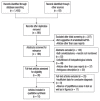Papilliferous Keratoameloblastoma: Systematic review
- PMID: 37655071
- PMCID: PMC10467561
- DOI: 10.18295/squmj.5.2023.021
Papilliferous Keratoameloblastoma: Systematic review
Abstract
Papilliferous keratoameloblastoma (PKA) is a rare entity, and not much is known about its clinicodemographic features or biological nature. This review aimed to provide clarity regarding the characterisation of the demographic, clinical, radiological and histopathological features of PKA. Case reports of PKA were identified through a systematic search across multiple databases. The search yielded a total of 10 cases, half of which were of Indian origin. All the cases invariably occurred in the mandibular posterior region and involved the right side; only one case primarily involved the left side of the mandible. PKA should be considered a variant of the conventional ameloblastoma that is towards the more aggressive end of the spectrum. It tends to occur in older individuals (in their fifth decade or older), with a marked propensity to occur in the right mandibular posterior region. Surgical resection with diligent follow-up is warranted in the treatment of PKA.
Keywords: Ameloblastoma; Keratin; Odontogenic Keratocyst; Odontogenic Tumors.
© Copyright 2023, Sultan Qaboos University Medical Journal, All Rights Reserved.
Figures


References
-
- Takata T, Slootweg PJ. Odontogenic and maxillofacial bone tumours. In: ElNaggar AK, Chan JK, Grandis JR, Takata T, Slootweg PJ, editors. WHO Classification of Head and Neck Tumours. 4th ed. Lyon, France: IARC; 2017. pp. 203–32.
Publication types
MeSH terms
LinkOut - more resources
Full Text Sources
